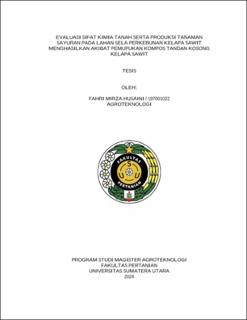Evaluasi Sifat Kimia Tanah serta Produksi Tanaman Sayuran pada Lahan Sela Perkebunan Kelapa Sawit Menghasilkan Akibat Pemupukan Kompos Tandan Kosong Kelapa Sawit
Intercropping Optimization Between Oil Palm Crops for Cultivation of Collards and Kale Using Oil Palm Empty Bunch Compost

Date
2024Author
Husaini, Fahri Mirza
Advisor(s)
Rauf, Abdul
Hanum, Hamidah
Metadata
Show full item recordAbstract
Every year the area of oil palm land continues to increase due to the ever-increasing demand. To optimize the potential of oil palm land, planting plants can be carried out between the oil palms (intercropping). Plants that have the potential to be developed on land between oil palm plantations are collards and kale. One of the organic materials that are widely available in oil palm plantations is empty palm fruit bunches which are used as compost. This study aims to determine the number of doses of empty palm fruit bunches compost needed to increase the growth of collards and kale as well as the chemical properties of the soil in the land between oil palm plantations. This research was conducted in a community-owned oil palm plantation in Pujidadi Village, South Binjai District, Binjai City. This study used a randomized block design with 2 factors. The first factor is the type of plant: Collards Plants, Kale Plants, and Combination Collards and Kale. The second factor is the compost of empty oil palm bunches: 0 ton ha-1, 12.5 ton ha-1, and 25 ton ha-1. The type of treatment of mustard plants showed differences in the wet weight of plants. Applying 12.5 tons ha-1 of empty palm oil bunches compost was able to increase pH soil, K-total soil, C-organic. Provision of empty palm oil bunches compost is recommended with chemical fertilizers to increase soil nutrients.
Collections
- Master Theses [429]
